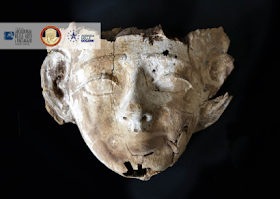On March 14, 2018, Italy's Carabinieri Command for the Protection of Cultural Heritage, better known as the Carabinieri T.P.C., informed the Egyptian embassy in Rome that during a routine customs inspection in May 2017, law enforcement officials from the TPC, in collaboration with the officials of the Customs Agency and the local Superintendency, had seized a reported 23,700 archaeological finds, all of which were believed to have come from ancient Egypt. The stash had been discovered inside a diplomatic shipping container, sent through the port of Salerno of the type used to transport household goods.
The Italian authorities shared that information with their Egyptian colleagues, including photos of the seized artefacts and promised to provide further clarification regarding the date and place of shipment, as well as details on the sender and the receiver, as soon as it was possible when the disclosure wouldn't hamper their ongoing investigation. To determine the objects' authenticity, the Egyptian authorities formed a specialized committee to examine pictures of the seized objects and to ensure that the artefacts were authentic. If they were, their next step was to try to understand where they came from.
When the news of the antiquities seizure hit the press wires, little information was released to the public. It was only stated that the haul came from a shipment of items belonging to an unnamed diplomat. As tensions grew between the two states, on May 24, 2018, the Egyptian Foreign Ministry made a formal announcement, denying that the seized container belonged to anyone affiliated with the Egyptian embassy or authorities in Italy.
When the news of the antiquities seizure hit the press wires, little information was released to the public. It was only stated that the haul came from a shipment of items belonging to an unnamed diplomat. As tensions grew between the two states, on May 24, 2018, the Egyptian Foreign Ministry made a formal announcement, denying that the seized container belonged to anyone affiliated with the Egyptian embassy or authorities in Italy.
 On May 25, 2018, Shaaban Abdel Gawad, who heads up Egypt's antiquities repatriation department within the Ministry of Antiquities, confirmed that the Egyptian authorities had deemed the artefacts to be authentic but the objects did not appear in any of the country's registries. This meant that the ancient objects, dating from the Predynastic to the Ptolemaic, as well as the Islamic era, had not been stolen from any known museum collection, and likely were the unrecorded finds of clandestine excavations of archaeological sites in Egypt.
On May 25, 2018, Shaaban Abdel Gawad, who heads up Egypt's antiquities repatriation department within the Ministry of Antiquities, confirmed that the Egyptian authorities had deemed the artefacts to be authentic but the objects did not appear in any of the country's registries. This meant that the ancient objects, dating from the Predynastic to the Ptolemaic, as well as the Islamic era, had not been stolen from any known museum collection, and likely were the unrecorded finds of clandestine excavations of archaeological sites in Egypt.The objects were believed to have come from an area on the edge of the western desert in the Minya province, located in central Egypt, 250 km south of Cairo. This artefact-rich area is known to have ancient catacombs that date back to the late pharaonic period, which spans from 664 to 332 BCE. The area has also been the subject to plunder and looting, which intensified after the country's revolution in 2011.
This confirmation by the Egyptian authorities put to rest early speculation in the press that these objects might have come from the Sinai region, an area where jihadist groups affiliated to ISIS had spread. After the artefacts' authenticity was confirmed, the General Prosecutor's Office in Cairo sent letters rogatory to Italy requesting formal assistance in early June 2018.
On June 27, 2018, at the headquarters of the Carabinieri Command for the Protection of Cultural Heritage, the Public Prosecutor at the Court of Salerno, Dr. Corrado Lembo and the Commander of the Carabinieri for the Protection of Cultural Heritage, Brigadier General Fabrizio Parrulli, returned a total of circa 23,000 ancient bronze and silver coins and 195 archaeological finds, including funerary masks decorated in gold, a sarcophagus, a "Boat of the Dead" with 40 oarsmen, amphorae, pectoral paintings, wooden sculptures, bronzes, and ushabti statuettes. These items were handed over to Egyptian Ambassador, HE Hesham Badr, Professor Mohamed Ezzat, Senior Coordinator at the International Cooperation Administration of the General Prosecutor's Office, and Professor Moustafa Waziry, Secretary-General of the Supreme Council of Antiquities for the Republic of Egypt.
On February 14, 2019, Egypt's Prosecutor General, Nabil Sadek, ordered 15 days of precautionary custody pending investigation for Raouf Boutros Ghali for his alleged involvement in the trafficking of the Egyptian artefacts which had been seized in Salerno. Raouf Boutros Ghali, who holds passports from Italy and San Marino, is the brother of the former Egyptian Minister of Finance, Youssef Botros Ghaly whose served in that role under then-President Hosni Mubarak from 2004 to 2011. He is also the nephew of Boutros Boutros-Ghali, Secretary-General of the United Nations from January 1992 to December 1996 who died in 2016. The Boutros-Ghali family are Coptic Christians with deep roots in Egypt's old aristocracy.
The prosecutor general in Egypt has also ordered the freezing assets attributed to the former honorary consul of Italy in Luxor, Cav. Ladislav Otakar Skakal. Skakal, who by then was believed to be back living in Rome, is believed to have been associated with the seized cargo. Egyptian authorities have also placed financial constraints on the liquidation of assets on Medhat Michel Girgis Salib, and his wife Sahar Zaki Ragheb. Egyptian news articles state that Salib is the owner of a shipping company.











No comments:
Post a Comment